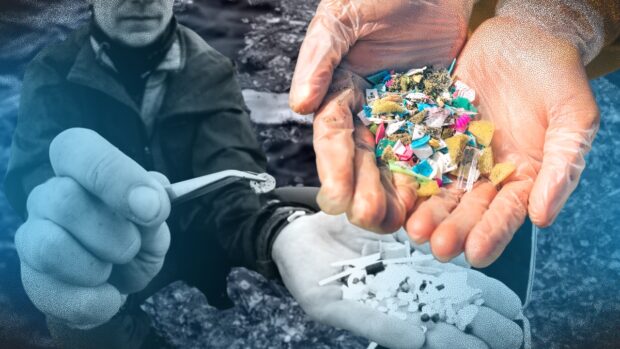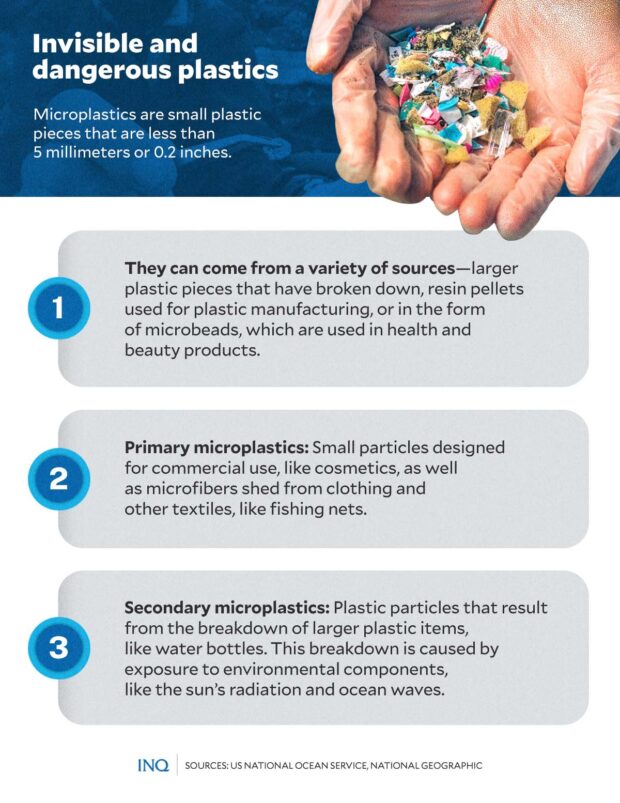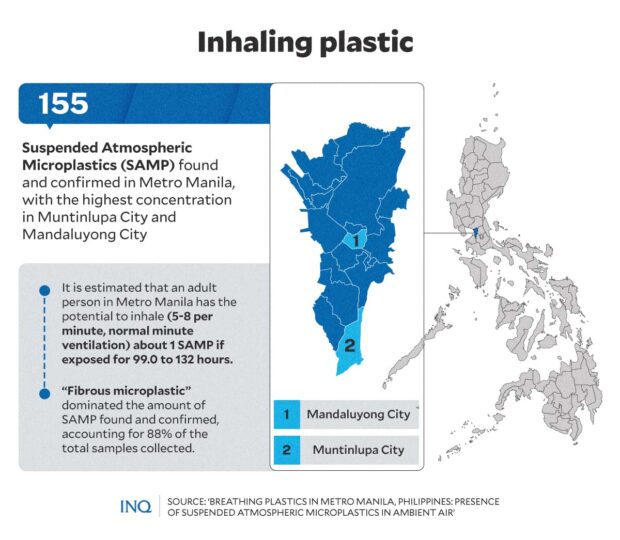Microplastics: Why we now already breathe, ingest killer plastics

COMPOSITE IMAGE: JEROME CRISTOBAL FROM INQ STOCK, AFP FILE PHOTOS
MANILA, Philippines—The world is being overwhelmed by plastic, the United Nations Environment Programme (UNEP) said as World Environment Day was marked on Monday (June 5).
UNEP said over 400 million tons of plastic is produced every year, 50 percent of which is designed only for single use. Out of that, less than 10 percent is recycled, so 19 to 23 million tons end up in lakes, rivers and seas.
Even the Department of Environment and Natural Resources (DENR) stressed that with 7,090 tons of plastic waste being produced every day, the Philippines is still far from winning the fight against single-use plastics.
READ: Filipinos losing war against single-use plastics – DENR
As UNEP pointed out, “today, plastic clogs our landfills, leaches into the ocean and is combusted into toxic smoke, making it one of the gravest threats to the planet.” It said “people’s actions on plastic pollution matters.”
This, however, is only the tip of the problem since “what is less known is that microplastics find their way into the food we eat, the water we drink and even the air we breathe.”
Article continues after this advertisementDangerous plastic bits
According to the United States National Oceanic and Atmospheric Administration (US NOAA), microplastics are small plastic pieces that are less than 5 millimeters or 0.2 inches.
Article continues after this advertisement“[They] can come from a variety of sources, including larger plastic pieces that have broken down, resin pellets used for plastic manufacturing, or in the form of microbeads, which are small and manufactured plastic beads used in health and beauty products.”

GRAPHIC Ed Lustan
There are two kinds of microplastics—primary and secondary.
As explained by National Geographic, the first one are small particles designed for commercial use, such as cosmetics, as well as microfibers shed from clothing and other textiles, such as fishing nets.
The second one, meanwhile, are plastic particles that result from the breakdown of larger plastic items, such as water bottles. This breakdown is caused by exposure to environmental components, like the sun’s radiation and ocean waves.
It was pointed out by the medical website WebMD that “secondary microplastics are more diverse than primary microplastics and can take forms ranging from fibers shed from synthetic clothing to pieces of a plastic spoon left in our rivers, lakes, and oceans.”
“Any plastic in the environment will eventually become a secondary microplastic as natural forces such as wind, water currents, and UV radiation break it down into smaller and smaller pieces,” WebMD said.
READ: There’s toxic plastic in your water: Groups see strong treaty as solution
National Geographic stressed that the problem with microplastics is that—like plastic particles of any size—they do not readily break down into harmless molecules as they take hundreds of years to decompose.
Contaminated water
Based on data, plastic can take anywhere from 20 to 500 years to degrade, and as pointed out by National Geographic, while taking hundreds of years, microplastics wreak havoc on the environment, even on health.
As years passed, these microplastics are already present in the Philippines.
In 2021, the DENR Ecosystems Research and Development Bureau said that microplastics have been confirmed to be present in selected waters, which were included in a study to determine the extent of microplastic contamination.

GRAPHIC Ed Lustan
Out of the 10 study sites in the Philippines, the Tañon Strait Protected Seascape in Badian and Moalboal, Cebu had the highest microplastic density—54 pieces/L.
Next to it were the Subic Bay in Zambales and Boracay Island in Aklan, which had a microplastic density of 34 pieces/L and 31 pieces/L. The contamination, meanwhile, was minimal in Apo Reef Natural Park in Occidental Mindoro with only 5 pieces/L.
According to Oceana, the Tañon Strait Protected Seascape, Apo Reef Natural Park, and the Taklong Island National Marine Reserve, where microplastics have also been confirmed to be present, are all marine protected areas.
Dirty air
Last month, a study by environmental scientists at Mindanao State University-Iligan Institute of Technology also revealed that microplastics are already present in Metro Manila air.
READ: Microplastics in Metro Manila air alarm scientists
First of its kind, the study, which was headed by Rodolfo Romarate II and Hernando Bacosa, sampled the ambient air of the 17 cities of the National Capital Region between Dec. 16 and 31, 2021.
Published in the Environmental Science and Pollution Research Journal, the study confirmed the existence of 155 suspended atmospheric microplastics (SAMPs), with the highest concentration in Muntinlupa City and Mandaluyong City.

GRAPHIC Ed Lustan
Malabon City had the lowest concentration.
Because of this, it was estimated that an adult person in Metro Manila “has the potential to inhale (5-8 per minute, normal minute ventilation) about 1 SAMP if exposed for about 99.0 to 132 h.”
“Fibrous microplastic,” mostly polyester that usually comes from the fluff of washed and dried clothes, dominated the amount of SAMP that have been confirmed to be present, accounting for 88 percent of the total samples collected.
Threats of microplastics
As an emerging field of study, “not a lot is known about microplastics and their impacts yet,” US NOAA said. It stressed, however, that these bits of plastic can be “harmful.”
It was pointed out by researcher Maya Ordoñez in a report published by WebMD that there are over 10,000 different chemicals used to alter a plastic’s physical characteristics.
Hanna Dusza (PhD), of the Institute for Risk Assessment Sciences at Utrecht University, explained that “as plastics degrade and become microplastics, these chemicals likely remain.”
“Recent research has shown that microplastics leach these chemicals locally in human tissues, or other areas of accumulation,” she told Ordoñez. There are 2,400 chemical additives classified as substances of potential concern.
Ordoñez was also told by Heather Leslie (PhD), a senior researcher of the Vrije Universiteit, that many of these chemicals also act as endocrine-disrupting compounds, or toxicants that imitate hormones when they enter the body.
The UNEP explained, too, that the surfaces of small fragments of plastic may carry disease-causing organisms and act as a vector for diseases in the environment.
Microplastics can also interact with soil fauna, affecting their health and soil functions.
As to the marine environment, meanwhile, a study published by the Institute of Physics stated that microplastics are widely distributed in the marine environment, because of their small particle sizes.
READ: MICROPLASTICS: INVISIBLE BANE TO PH FISHERMEN
“They are easily eaten by marine life, and produce a series of toxic effects, including inhibition of growth and development, impact on feeding and behavioral ability, reproductive toxicity, immunity toxicity, genetic damage.”
‘Act now’
Because of these, Oceana reiterated its call on the DENR and the National Solid Waste Commission (NSWMC) to ban single-use plastics, stressing that the government should, once and for all, address plastic pollution in the Philippines.
“Microplastics are in the air we breathe and, in the soil, freshwater, and our seas. Our exposure to the dangers brought about by plastic pollution cannot be overemphasized,” said lawyer Rose Liza Eisma-Osorio, Oceana’s acting vice president.
“Plastic is an escalating crisis for the environment, health, and climate. If we don’t act now to mitigate its impacts, when will the government move? Banning single-use plastics with utmost sense of urgency is a must now more than ever,” she said.
Based on Republic Act No. 9003, or the Ecological Solid Waste Act of 2000, within one year from its effectivity, the NSWMC shall, after public notice and hearing, prepare a list of non-environmentally acceptable products.
Provided, however, that non-environmentally acceptable products shall not be prohibited unless the NSWMC first finds that there are alternatives available which are available to consumers at no more than 10 percent greater cost than the disposable product.
Earlier this year, Environment Secretary Antonia Loyzaga signed the Implementing Rules and Regulations of Republic Act No. 11898, or the Extended Producer Responsibility Act of 2022.
This, to address the mismanagement of plastic waste and uphold circularity by maximizing the material value of plastics as it serves as the environmental policy approach and practice that requires producers to be responsible.
The problem, however, is that only 600 companies have complied with the law.
The DENR is likewise intensifying the implementation of the Ecological Solid Waste Act of 2000, especially with the approval of the solid waste management plans (SWMP) of 54 towns.
As of May 2023, only 70 percent of local government units have approved SWMPs.
Delays in the preparation and approval of the plans were hampering their implementation, an INQUIRER report revealed, based on a Commission on Audit report last April.
Poor waste management
As stressed by the Alliance to End Plastic Waste, “plastic is a life-changing resource, but the same qualities that make it useful—alongside poor waste management—have created a global waste challenge.”
It said “in many applications, plastic is virtually irreplaceable because it is cheap, strong, lightweight, and resistant to corrosion.” The most common uses of plastic are in packaging and building components.
RELATED STORY: Online shopping rise brings phenomenal volume of plastic wastes
But while plastic is durable, this also means that plastic waste “can be trapped in our environment for centuries, if not managed well,” it said while stressing the need to transition to a more sustainable model.
It said “plastic recycling is a crucial step towards a circular economy, but achieving circularity calls for action at every point in the lifetime of a product: from design to waste management.”
The Alliance to End Plastic Waste said it focuses on six action areas that advance our trajectory toward a circular economy and ending plastic waste in the environment. They are:
- Front-end Design
Designing products that can last long and are easy to repair, and eventually can be recycled.
- Access to Collection
Providing basic infrastructure enabling convenient and necessary recovery of waste, preventing leakage into the environment.
- Participation and Engagement
Raising awareness and inspiring participation in sustainable practices and clean-up.
- Sorting
The first step of any recycling system is sorting waste according to type, wet or dry; recyclable or non-recyclable; plastic, paper, metal, or glass. Sorting like this can happen right inside your home, or at a formal waste management facility.
- Processing
Scaling solutions of new advanced recovery and recycling methods, including both mechanical and chemical recycling.
- End Markets
Growing market demand for recycled materials from all recycling methods.
But in the meantime, here are some alternatives to single-use plastics such as water bottles, plastic straws, and plastic shopping bags:
- Use reusable water bottles
- Go straw free
- Use glass bottles or containers
- Bring your own shopping bags
- Reuse plastic containers
- Get refillable household and kitchen products